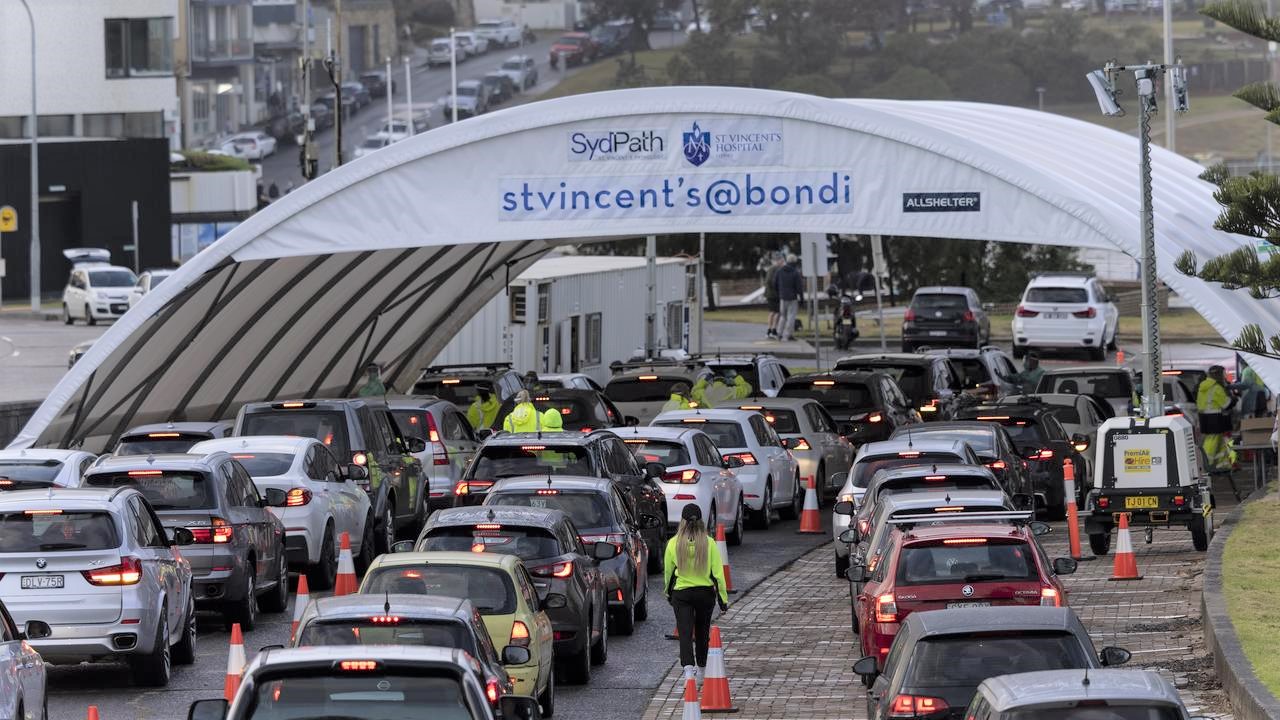NSW to hit 2200 cases a day if virus continues to spread at current rate


Almost 4000 unlinked mystery cases are fuelling the spread of coronavirus in NSW with fears the state will hit daily case numbers of more than 2200 if the current reproductive rate is not reduced.
Premier Gladys Berejiklian and Chief Health Officer Kerry Chant on Wednesday issued their gravest warning of the pandemic, admitting the virus reproductive rate of 1.3 indicated that the worst was still to come.
The state on Wednesday reported its biggest daily surge in case numbers, with 633 new local cases and another three deaths. At least 92 cases were in the community during their infectious period, while health authorities are yet to link 3803 mystery cases to their source.
Leading epidemiologist James McCaw, who advises the federal government, said cases will likely continue to rise in the next two weeks with the possibility of numbers reaching into the thousands within the next month.
Dr Chant said she was unable to express her level of concern at the rising numbers, warning NSW would see more hospital admissions and more deaths if the numbers continued to rise.
The state’s current reproductive rate of 1.3 means every 10 infected people could spread the virus to 13 others.
“We need that number to be below one … that’s what will turn the corner, and until we hit that corner we’re going to see case numbers rise,” Ms Berejiklian said.
She said reducing mobility was critical in curbing the spread, but rejected any assertion that people were confused by public health orders or that stricter measures were needed.
“Stay at home. Don’t break the rules, everybody knows what they mean. Just a small number of people are choosing to ignore what the rules are.”
Around 550 of the new cases are young people and workers in western and south-west Sydney, where movement between households remains one of the biggest factors in transmission.
Merrylands, Guildford, Auburn, Greenacre, Yagoona, St Marys and Strathfield are key suburbs of concern.
Ms Berejiklian said, given the high viral load in essential workers moving in and out of hotspots, “there could be an outbreak anywhere.”
University of Melbourne’s Professor McCaw, who is a member of the Australian Health Protection Principal Committee, said he would not be surprised if the state recorded up to 2000 daily cases within a month.
“However it could go lower too. Our models show the possibility of increases and decreases, but I think it’s more likely to be well over 1000 and up to 2000 within a month or so,” he said.
Professor McCaw said it was “deeply concerning” there were still thousands of unlinked cases, meaning the situation was likely to deteriorate rather than improve.
He said despite the reported reproductive rate of about 1.3, the figure would be lower in some parts of the state and higher in others, adding that increasing vaccination coverage will ultimately help reduce new cases.
Dr Chant said the reproductive rate needed to fall below 1 before case numbers started declining, urging the community to decrease mobility to stop the spread.
“Every person is passing on the virus to more than one person, so we are continuing to see case numbers increase,” she said.
“You might have one person who has connections across three households, but in each of those households you’ve got tens of people. And we know that household transmission for COVID is so common,” she said.
Dr Chant said she wanted to see fewer people in settings like workplaces and childcare centres.
Data journalist Juliette O’Brien, who has been tracking COVID cases since the pandemic began, said the “outbreak is at a point now of absolutely taking off”.
Ms O’Brien said based on a current five-day average of about 470 cases, and with a reproductive rate of 1.3, daily cases would reach above 2200 within the next month.
“NSW has to some degree been keeping a lid on Delta until this point. And I think that has lured us into a sense of complacency,” she said.
“On June 18 we had one case under investigation, today we have 3803. More than one third of cases in the outbreak have no known link to a cluster. And the vast majority, about 88 per cent, are located in 12 LGAs of concern.
“Cases are growing too quickly for our vaccination targets,” said Ms O’Brien. “We are running toward vaccine targets and with these case numbers we are not running fast enough.”
Ms Berejiklian has consistently maintained the state’s lockdown settings are some of the harshest in Australia, and that she would only consider stricter measures if they were based on health advice.
Dr Chant said she engaged in regular discussions with Ms Berejiklian about “what more we can do,” insisting that they had a “shared vision”.
“We continually reflect on the data, any intelligence we’re getting about how transmission is occurring and keep on updating our ideas and concepts,” she said.
People aged 16 to 39 in Sydney’s 12 local government areas of concern will start receiving Pfizer jabs at ten sites from Thursday after appointment bookings for the vaccination drive opened on Wednesday.
The ambitious plan to inoculate more than half a million young people in two-and-a-half weeks has forced the temporary cancellation of non-urgent elective surgery at private hospitals across greater Sydney, the Blue Mountains, Central Coast, Wollongong and regional locations.
Health workers across the private hospital network, as well as others from smaller vaccination clinics and services like Breast Screen NSW, will help manage the roll-out.
In Liverpool, four mobile AstraZeneca walk-in clinics will temporarily close for two-and-a-half weeks to allow health workers to boost the roll-out of Pfizer jabs at the Liverpool Vaccination Clinic.
Labor health spokesman Ryan Park said closing a smaller clinic was not the solution as the outbreak worsened.
“We want more places for people to get vaccinated, not less, and we don’t want a situation where these major vaccination hubs end up being superspreaders of the virus because thousands of people are forced to wait in lines for hours to get a vaccine,” he said.
Labor member for Auburn Lynda Voltz said her diverse electorate urgently needed access to vaccination in smaller multicultural sites.
“Nearly every day this week the Premier has stated Auburn is an area of concern. Well, it is hard to tell from the government’s response, with no information on where resources are going and no pop up clinics.”
There are currently 462 COVID-19 cases admitted to hospital, including 77 people in intensive care. Twenty-five patients require ventilation.
Source: smh.com.au




